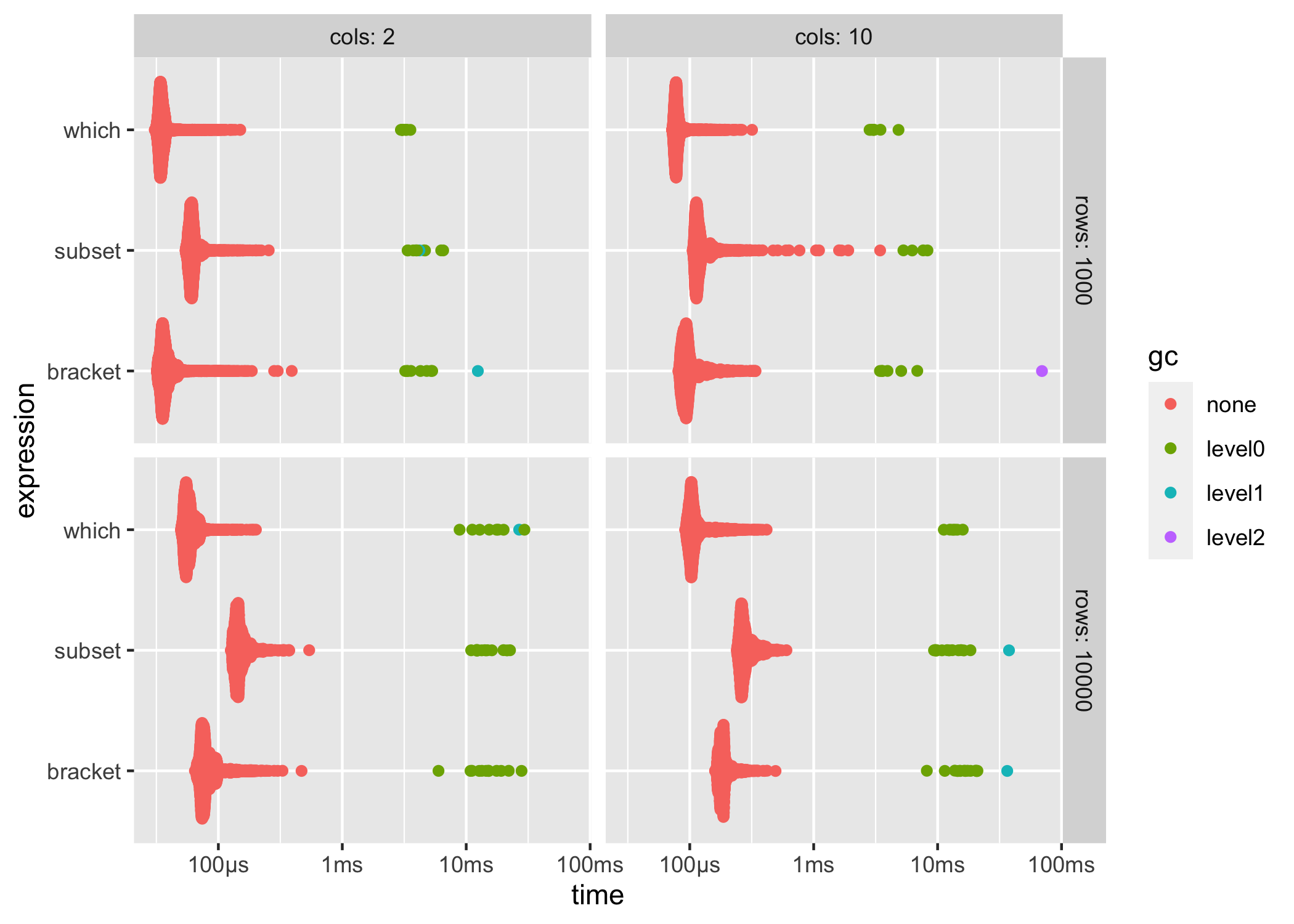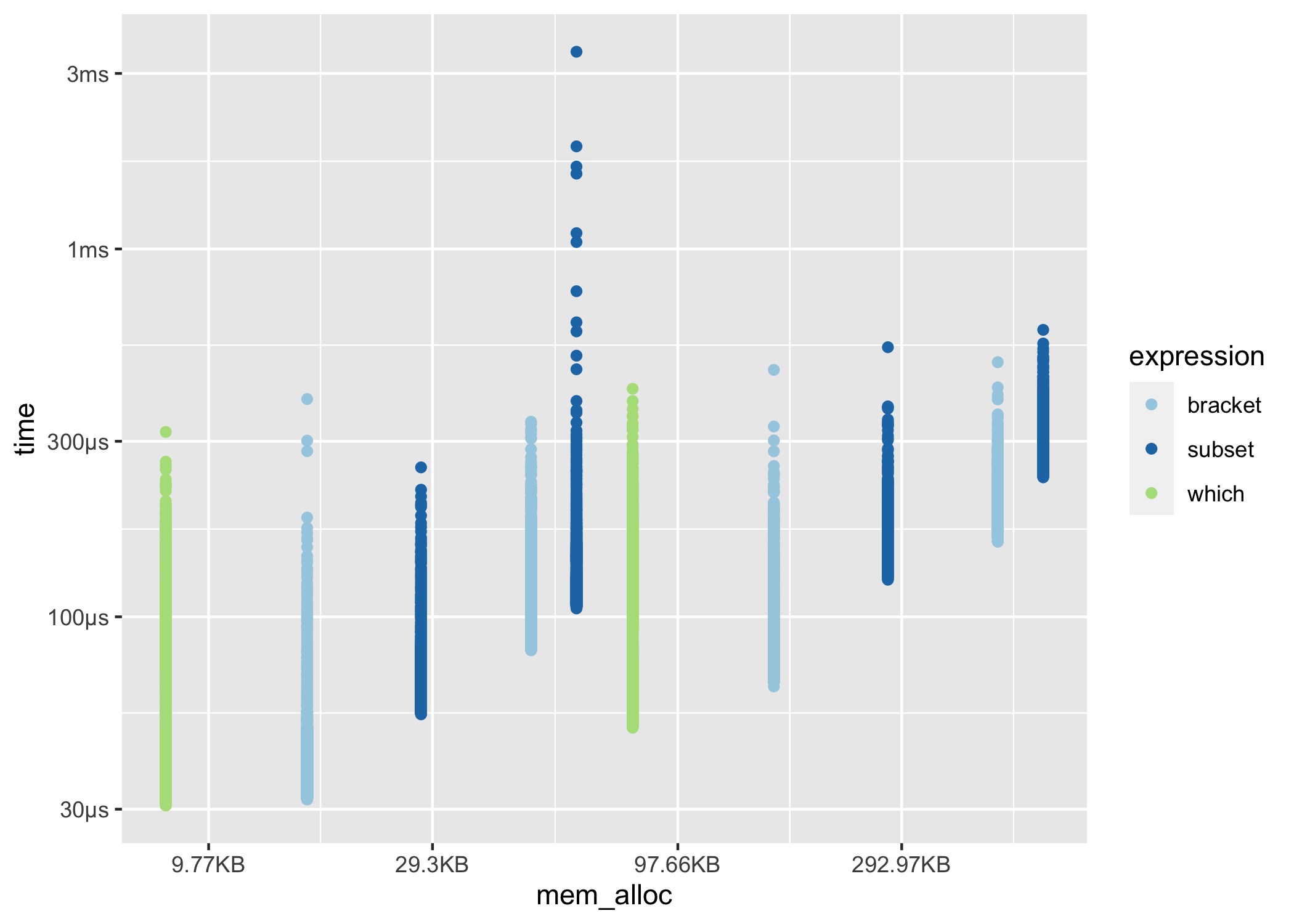The goal of bench is to benchmark code, tracking execution time, memory allocations and garbage collections.
You can install the release version from CRAN with:
install.packages("bench")Or you can install the development version from GitHub with:
# install.packages("pak")
pak::pak("r-lib/bench")bench::mark() is used to benchmark one or a series of
expressions, we feel it has a number of advantages over alternatives.
bench::press(), which allows you to easily perform
and combine benchmarks across a large grid of values.The times and memory usage are returned as custom objects which have
human readable formatting for display (e.g. 104ns) and
comparisons (e.g. x$mem_alloc > "10MB").
There is also full support for plotting with ggplot2 including custom scales and formatting.
bench::mark()Benchmarks can be run with bench::mark(), which takes
one or more expressions to benchmark against each other.
library(bench)
set.seed(42)
dat <- data.frame(
x = runif(10000, 1, 1000),
y = runif(10000, 1, 1000)
)bench::mark() will throw an error if the results are not
equivalent, so you don’t accidentally benchmark inequivalent code.
bench::mark(
dat[dat$x > 500, ],
dat[which(dat$x > 499), ],
subset(dat, x > 500)
)
#> Error: Each result must equal the first result:
#> `dat[dat$x > 500, ]` does not equal `dat[which(dat$x > 499), ]`Results are easy to interpret, with human readable units.
bnch <- bench::mark(
dat[dat$x > 500, ],
dat[which(dat$x > 500), ],
subset(dat, x > 500)
)
bnch
#> # A tibble: 3 × 6
#> expression min median `itr/sec` mem_alloc `gc/sec`
#> <bch:expr> <bch:tm> <bch:tm> <dbl> <bch:byt> <dbl>
#> 1 dat[dat$x > 500, ] 151µs 202µs 4994. 377KB 36.8
#> 2 dat[which(dat$x > 500), ] 124µs 168µs 6169. 260KB 33.2
#> 3 subset(dat, x > 500) 184µs 232µs 3911. 510KB 40.3By default the summary uses absolute measures, however relative
results can be obtained by using relative = TRUE in your
call to bench::mark() or calling
summary(relative = TRUE) on the results.
summary(bnch, relative = TRUE)
#> # A tibble: 3 × 6
#> expression min median `itr/sec` mem_alloc `gc/sec`
#> <bch:expr> <dbl> <dbl> <dbl> <dbl> <dbl>
#> 1 dat[dat$x > 500, ] 1.22 1.20 1.28 1.45 1.11
#> 2 dat[which(dat$x > 500), ] 1 1 1.58 1 1
#> 3 subset(dat, x > 500) 1.48 1.38 1 1.96 1.21bench::press()bench::press() is used to run benchmarks against a grid
of parameters. Provide setup and benchmarking code as a single unnamed
argument then define sets of values as named arguments. The full
combination of values will be expanded and the benchmarks are then
pressed together in the result. This allows you to benchmark a
set of expressions across a wide variety of input sizes, perform
replications and other useful tasks.
set.seed(42)
create_df <- function(rows, cols) {
out <- replicate(cols, runif(rows, 1, 100), simplify = FALSE)
out <- setNames(out, rep_len(c("x", letters), cols))
as.data.frame(out)
}
results <- bench::press(
rows = c(1000, 10000),
cols = c(2, 10),
{
dat <- create_df(rows, cols)
bench::mark(
min_iterations = 100,
bracket = dat[dat$x > 500, ],
which = dat[which(dat$x > 500), ],
subset = subset(dat, x > 500)
)
}
)
#> Running with:
#> rows cols
#> 1 1000 2
#> 2 10000 2
#> 3 1000 10
#> 4 10000 10
results
#> # A tibble: 12 × 8
#> expression rows cols min median `itr/sec` mem_alloc `gc/sec`
#> <bch:expr> <dbl> <dbl> <bch:tm> <bch:tm> <dbl> <bch:byt> <dbl>
#> 1 bracket 1000 2 27µs 34µs 27964. 15.84KB 19.6
#> 2 which 1000 2 25.7µs 33.4µs 29553. 7.91KB 17.7
#> 3 subset 1000 2 45.9µs 58.2µs 16793. 27.7KB 17.1
#> 4 bracket 10000 2 64.1µs 70.8µs 13447. 156.46KB 40.5
#> 5 which 10000 2 46.7µs 54.7µs 17586. 78.23KB 23.3
#> 6 subset 10000 2 116.2µs 132.1µs 7228. 273.79KB 40.9
#> 7 bracket 1000 10 77.2µs 85.4µs 11335. 47.52KB 19.9
#> 8 which 1000 10 67.8µs 75.2µs 13073. 7.91KB 23.2
#> 9 subset 1000 10 84.7µs 107.5µs 9281. 59.38KB 18.8
#> 10 bracket 10000 10 130.2µs 169.1µs 5799. 469.4KB 52.2
#> 11 which 10000 10 75.1µs 96µs 10187. 78.23KB 17.4
#> 12 subset 10000 10 222.7µs 253µs 3810. 586.73KB 43.3ggplot2::autoplot() can be used to generate an
informative default plot. This plot is colored by gc level (0, 1, or 2)
and faceted by parameters (if any). By default it generates a beeswarm
plot, however you can also specify other plot types
(jitter, ridge, boxplot,
violin). See ?autoplot.bench_mark for full
details.
ggplot2::autoplot(results)
You can also produce fully custom plots by un-nesting the results and working with the data directly.
library(tidyverse)
results %>%
unnest(c(time, gc)) %>%
filter(gc == "none") %>%
mutate(expression = as.character(expression)) %>%
ggplot(aes(x = mem_alloc, y = time, color = expression)) +
geom_point() +
scale_color_bench_expr(scales::brewer_pal(type = "qual", palette = 3))
system_time()bench also includes system_time(), a
higher precision alternative to system.time().
bench::system_time({
i <- 1
while (i < 1e7) {
i <- i + 1
}
})
#> process real
#> 1.73s 1.7s
bench::system_time(Sys.sleep(.5))
#> process real
#> 58µs 497ms